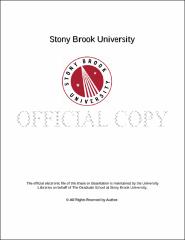| dc.identifier.uri | http://hdl.handle.net/11401/76129 | |
| dc.description.sponsorship | This work is sponsored by the Stony Brook University Graduate School in compliance with the requirements for completion of degree. | en_US |
| dc.format | Monograph | |
| dc.format.medium | Electronic Resource | en_US |
| dc.language.iso | en_US | |
| dc.publisher | The Graduate School, Stony Brook University: Stony Brook, NY. | |
| dc.type | Dissertation | |
| dcterms.abstract | We look into the ENSO modulation of QBO amplitudes and periods using IGRA data, for the time from the 1950s to the 2010s (the whole period), and the separated time intervals before 1982 and after 1990. For the whole period and the time interval after 1990, the QBO has longer period and larger amplitude during La Niña than during El Niño. However, before 1982 there is no conclusive relationship between the QBO amplitude for the two ENSO phases, although the QBO period is still longer during La Niña. Since the period of the QBO is determined by the magnitude of the wave momentum flux driving the QBO, and the amplitude of the QBO is determined by the magnitude of the wave phase speeds that comprise the gravity wave spectrum. We then offer a possible explanation of how changes in deep convection might cause the ENSO-QBO relationship change before and after the 1980s, using OLR data. We also use the cloud resolving model SAM to investigate the QBO influence on tropical deep convection. The downward penetration of the QBO temperature perturbation near the tropopause is crucial for the QBO modulation on the convection while the QBO wind shear has a very small effect. In the idealized Walker circulation experiments there is more precipitation in the area with the strongest precipitation during periods of QBO westerly phase. The idealized Walker circulation experiments with upper-level temperature perturbation reveals a potential mechanism for the QBO effects on the tropical circulation and associated convection. With a cold temperature anomaly near the tropopause, the tropopause height is lifted upward. The vertical extension of the raising branch of the Walker circulation also increases in height, moving the peak of the vertical velocity profile [i.e. the level of the divergence] upward. The upward moving of the peak level of the w profile increases the gross moist stability. Thus, assuming the input of the moist static energy is approximately unchanged in the rising branch of the Walker cell, its precipitation will decrease, and the decrease precipitation is increased in the region outside the center of the Walker cell, as a result of this Walker circulation change. | |
| dcterms.abstract | We look into the ENSO modulation of QBO amplitudes and periods using IGRA data, for the time from the 1950s to the 2010s (the whole period), and the separated time intervals before 1982 and after 1990. For the whole period and the time interval after 1990, the QBO has longer period and larger amplitude during La Niña than during El Niño. However, before 1982 there is no conclusive relationship between the QBO amplitude for the two ENSO phases, although the QBO period is still longer during La Niña. Since the period of the QBO is determined by the magnitude of the wave momentum flux driving the QBO, and the amplitude of the QBO is determined by the magnitude of the wave phase speeds that comprise the gravity wave spectrum. We then offer a possible explanation of how changes in deep convection might cause the ENSO-QBO relationship change before and after the 1980s, using OLR data. We also use the cloud resolving model SAM to investigate the QBO influence on tropical deep convection. The downward penetration of the QBO temperature perturbation near the tropopause is crucial for the QBO modulation on the convection while the QBO wind shear has a very small effect. In the idealized Walker circulation experiments there is more precipitation in the area with the strongest precipitation during periods of QBO westerly phase. The idealized Walker circulation experiments with upper-level temperature perturbation reveals a potential mechanism for the QBO effects on the tropical circulation and associated convection. With a cold temperature anomaly near the tropopause, the tropopause height is lifted upward. The vertical extension of the raising branch of the Walker circulation also increases in height, moving the peak of the vertical velocity profile [i.e. the level of the divergence] upward. The upward moving of the peak level of the w profile increases the gross moist stability. Thus, assuming the input of the moist static energy is approximately unchanged in the rising branch of the Walker cell, its precipitation will decrease, and the decrease precipitation is increased in the region outside the center of the Walker cell, as a result of this Walker circulation change. | |
| dcterms.available | 2017-09-20T16:42:26Z | |
| dcterms.contributor | Geller, Marvin A. | en_US |
| dcterms.contributor | Chang, Edmund | en_US |
| dcterms.contributor | Khairoutdinov, Marat | en_US |
| dcterms.contributor | Hameed, Sultan | en_US |
| dcterms.contributor | Rosenlof, Karen. | en_US |
| dcterms.creator | Yuan, Wei | |
| dcterms.dateAccepted | 2017-09-20T16:42:26Z | |
| dcterms.dateSubmitted | 2017-09-20T16:42:26Z | |
| dcterms.description | Department of Marine and Atmospheric Science. | en_US |
| dcterms.extent | 168 pg. | en_US |
| dcterms.format | Application/PDF | en_US |
| dcterms.format | Monograph | |
| dcterms.identifier | http://hdl.handle.net/11401/76129 | |
| dcterms.issued | 2015-12-01 | |
| dcterms.language | en_US | |
| dcterms.provenance | Made available in DSpace on 2017-09-20T16:42:26Z (GMT). No. of bitstreams: 1
Yuan_grad.sunysb_0771E_12548.pdf: 2716698 bytes, checksum: 826adc3027c6733b0a98ea9be736376a (MD5)
Previous issue date: 1 | en |
| dcterms.publisher | The Graduate School, Stony Brook University: Stony Brook, NY. | |
| dcterms.subject | ENSO, QBO, Stratosphere-Troposphere interaction, Tropical deep convection | |
| dcterms.subject | Atmospheric sciences | |
| dcterms.title | ENSO modulation of the QBO, and QBO influence on tropical convection | |
| dcterms.type | Dissertation | |

